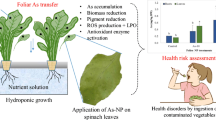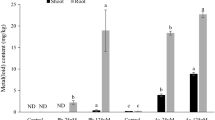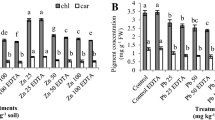Abstract
Atmospheric contamination by heavy metal(loid)s is a widespread global issue. Recent studies have shown foliar pathway of heavy metal(loid) uptake by plants, thus menacing plant productivity and threatening health risks. In contrast to root uptake of heavy metal(loid)s, there is scarce data available on heavy metal(loid) foliar uptake, accumulation in different plant parts, changes in growth and other biophysiochemical processes/reactions, detoxification mechanisms and associated health risks due to the consumption of contaminated vegetables. This study evaluated the effect of foliar application of two potentially toxic metal(loid)s (arsenic (As) and lead (Pb)) on their uptake by Spinacia oleracea, plant growth, pigment contents, physiological changes, and activation of antioxidative enzymes. Results revealed that S. oleracea seedlings can accumulate both the metal(loid)s in their leaves via foliar pathway. Arsenic was transferred from the leaves towards the roots, while Pb was mainly sequestered in S. oleracea leaves. Both the metal(loid)s significantly decreased plant growth and pigment contents, As being more toxic than Pb. Foliar application of As and Pb did not cause lipid peroxidation and overproduction of reactive oxygen species (ROS). However, both the metal(loid)s enhanced the activities of antioxidative enzymes. We also calculated possible health risks (both non-carcinogenic and carcinogenic) due to As and Pb accumulation in the edible parts for both the adults and children. It was observed that As can induce non-carcinogenic effects (HQ > 1) in children only, while both As and Pb can cause carcinogenic hazards in both adults and children under their all applied foliar levels. Therefore, it is proposed that As and Pb contents in the atmosphere must be monitored continuously for their possible foliar uptake and accumulation in edible plant parts to avoid cancer risks. Moreover, multivariate analysis traced weak-strong correlations between metal(loid) treatments and plant response variables.



Similar content being viewed by others
References
Abbas G, Murtaza B, Bibi I, Shahid M, Niazi N, Khan M, Amjad M, Hussain M, Natasha (2018) Arsenic uptake, toxicity, detoxification, and speciation in plants: physiological, biochemical, and molecular aspects. Int J Environ Res Public Health 15:59
Aebi H (1984) Catalase in vitro. Methods Enzymol 105:121–126
Antoniadis V, Shaheen SM, Levizou E, Shahid M, Niazi NK, Vithanage M, Ok YS, Bolan N, Rinklebe J (2019) A critical prospective analysis of the potential toxicity of trace element regulation limits in soils worldwide: are they protective concerning health risk assessment?-a review. Environ Int 127:819–847
ATSDR (2007) Toxicological profile for arsenic. Agency for Toxic Substances and Disease Registry
Bakhat HF, Zia Z, Fahad S, Abbas S, Hammad HM, Shahzad AN, Abbas F, Alharby H, Shahid M (2017) Arsenic uptake, accumulation and toxicity in rice plants: possible remedies for its detoxification: a review. Environ Sci Pollut Res 24:9142–9158
Bondada BR, Tu S, Ma LQ (2004) Absorption of foliar-applied arsenic by the arsenic hyperaccumulating fern (Pteris vittata L.). Sci Total Environ 332:61–70
Chowdhury NR, Das R, Joardar M, Ghosh S, Bhowmick S, Roychowdhury T (2018) Arsenic accumulation in paddy plants at different phases of pre-monsoon cultivation. Chemosphere 210:987–997
Dhindsa RS, Plumb-Dhindsa P, Thorpe TA (1981) Leaf senescence: correlated with increased levels of membrane permeability and lipid peroxidation, and decreased levels of superoxide dismutase and catalase. J Exp Bot 32:93–101
Dumat C, Xiong T, Shahid M (2016) Agriculture urbaine durable: Opportunité pour la transition écologique. OmniScriptum, Germany, Germany, pp 1–80
El Hayek E, El Samrani A, Lartiges B, Kazpard V, Aigouy T (2017) Lead bioaccumulation in Opuntia ficus-indica following foliar or root exposure to lead-bearing apatite. Environ Pollut 220:779–787
Gajbhiye T, Pandey SK, Kim K-H, Szulejko JE, Prasad S (2016) Airborne foliar transfer of PM bound heavy metals in Cassia siamea: a less common route of heavy metal accumulation. Sci Total Environ 573:123–130
Gunawardena J, Egodawatta P, Ayoko GA, Goonetilleke A (2013) Atmospheric deposition as a source of heavy metals in urban stormwater. Atmos Environ 68:235–242
Hariram M, Sahu R, Elumalai SP (2018) Impact assessment of atmospheric dust on foliage pigments and pollution resistances of plants grown nearby coal based thermal power plants. Arch Environ Contam Toxicol 74:56–70
Hemeda HM, Klein B (1990) Effects of naturally occurring antioxidants on peroxidase activity of vegetable extracts. J Food Sci 55:184–185
Hodges DM, DeLong JM, Forney CF, Prange RK (1999) Improving the thiobarbituric acid-reactive-substances assay for estimating lipid peroxidation in plant tissues containing anthocyanin and other interfering compounds. Planta 207:604–611
Huang H, Jiang Y, Xu X, Cao X (2018) In vitro bioaccessibility and health risk assessment of heavy metals in atmospheric particulate matters from three different functional areas of Shanghai, China. Sci Total Environ 610:546–554
Jadoon WA, Khpalwak W, Chidya RCG, Abdel-Dayem SMMA, Takeda K, Makhdoom MA, Sakugawa H (2018) Evaluation of levels, sources and health hazards of road-dust associated toxic metals in Jalalabad and Kabul cities, Afghanistan. Arch Environ Contam Toxicol 74:32–45
Khalid S, Shahid M, Dumat C, Niazi NK, Bibi I, Gul Bakhat HFS, Abbas G, Murtaza B, Javeed HMR (2017) Influence of groundwater and wastewater irrigation on lead accumulation in soil and vegetables: implications for health risk assessment and phytoremediation. Int J Phytoremediation:0–0
Kim HS, Kim K-R, Kim W-I, Owens G, Kim K-H (2017) Influence of road proximity on the concentrations of heavy metals in Korean urban agricultural soils and crops. Arch Environ Contam Toxicol 72:260–268
Klink A, Polechońska L, Dambiec M, Białas K (2018) A comparative study on macro-and microelement bioaccumulation properties of leaves and bark of Quercus petraea and Pinus sylvestris. Arch Environ Contam Toxicol 74:71–79
Kováčik J, Dresler S, Peterková V, Babula P (2018) Metal-induced oxidative stress in terrestrial macrolichens. Chemosphere 203:402–409
Li X, Li Z, Lin C-J, Bi X, Liu J, Feng X, Zhang H, Chen J, Wu T (2018) Health risks of heavy metal exposure through vegetable consumption near a large-scale Pb/Zn smelter in Central China. Ecotoxicol Environ Saf 161:99–110
Lichtenthaler HK (1987): [34] chlorophylls and carotenoids: pigments of photosynthetic biomembranes, Plant Cell Membranes Academic Press, pp. 350–382
Liu Y, Xing J, Wang S, Fu X, Zheng H (2018) Source-specific speciation profiles of PM 2.5 for heavy metals and their anthropogenic emissions in China. Environ Pollut 239:544–553
Mombo S, Foucault Y, Deola F, Gaillard I, Goix S, Shahid M, Schreck E, Pierart A, Dumat C (2016) Management of human health risk in the context of kitchen gardens polluted by lead and cadmium near a lead recycling company. J Soils Sediments 16:1214–1224
Natasha SM, Dumat C, Khalid S, Rabbani F, Farooq ABU, Amjad M, Abbas G, Niazi NK (2018a) Foliar uptake of arsenic nanoparticles by spinach: an assessment of physiological and human health risk implications. Environ Sci Pollut Res Int 26:20121–20131
Natasha SM, Niazi NK, Khalid S, Murtaza B, Bibi I, Rashid MI (2018b) A critical review of selenium biogeochemical behavior in soil-plant system with an inference to human health. Environ Pollut 234:915–934
Natasha, Shahid M, Khalid S, Dumat C, Pierart A, Niazi NK (2019) Biogeochemistry of antimony in soil-plant system: ecotoxicology and human health. Applied Geochemistry
Phi TH, Chinh PM, Cuong DD, Ly LTM, Van Thinh N, Thai PK (2018) Elemental concentrations in roadside dust along two National Highways in Northern Vietnam and the health-risk implication. Arch Environ Contam Toxicol 74:46–55
Pourrut B, Shahid M, Dumat C, Winterton P, Pinelli E (2011) Lead uptake, toxicity, and detoxification in plants. Rev Environ Contam Toxicol 213:113–136
Raessler M (2018) The arsenic contamination of drinking and groundwaters in Bangladesh: featuring biogeochemical aspects and implications on public health. Arch Environ Contam Toxicol 75:1–7
Rizvi A, Khan MS (2018) Heavy metal induced oxidative damage and root morphology alterations of maize (Zea mays L.) plants and stress mitigation by metal tolerant nitrogen fixing Azotobacter chroococcum. Ecotoxicol Environ Saf 157:9–20
Sawut R, Kasim N, Maihemuti B, Hu L, Abliz A, Abdujappar A, Kurban M (2018) Pollution characteristics and health risk assessment of heavy metals in the vegetable bases of northwest China. Sci Total Environ 642:864–878
Schreck E, Foucault Y, Sarret G, Sobanska S, Cécillon L, Castrec-Rouelle M, Uzu G, Dumat C (2012) Metal and metalloid foliar uptake by various plant species exposed to atmospheric industrial fallout: mechanisms involved for lead. Sci Total Environ 427:253–262
Schreck E, Laplanche C, Le Guédard M, Bessoule J-J, Austruy A, Xiong T, Foucault Y, Dumat C (2013) Influence of fine process particles enriched with metals and metalloids on Lactuca sativa L. leaf fatty acid composition following air and/or soil-plant field exposure. Environ Pollut 179:242–249
Schreck E, Dappe V, Sarret G, Sobanska S, Nowak D, Nowak J, Stefaniak EA, Magnin V, Ranieri V, Dumat C (2014) Foliar or root exposures to smelter particles: consequences for lead compartmentalization and speciation in plant leaves. Sci Total Environ 476-477:667–676
Shahid M, Pinelli E, Pourrut B, Silvestre J, Dumat C (2011) Lead-induced genotoxicity to Vicia faba L. roots in relation with metal cell uptake and initial speciation. Ecotoxicol Environ Saf 74:78–84
Shahid M, Pinelli E, Dumat C (2012) Review of Pb availability and toxicity to plants in relation with metal speciation; role of synthetic and natural organic ligands. J Hazard Mater 219:1–12
Shahid M, Pourrut B, Dumat C, Nadeem M, Aslam M, Pinelli E (2014): Heavy-metal-induced reactive oxygen species: phytotoxicity and physicochemical changes in plants, reviews of environmental contamination and toxicology volume 232. Springer, pp. 1-44
Shahid M, Dumat C, Khalid S, Schreck E, Xiong T, Niazi NK (2017a) Foliar heavy metal uptake, toxicity and detoxification in plants: a comparison of foliar and root metal uptake. J Hazard Mater 325:36–58
Shahid M, Rafiq M, Niazi NK, Dumat C, Shamshad S, Khalid S, Bibi I (2017c) Arsenic accumulation and physiological attributes of spinach in the presence of amendments: an implication to reduce health risk. Environ Sci Pollut Res 24:16097–16106
Shahid M, Pinelli E, Dumat C (2018) Tracing trends in plant physiology and biochemistry: need of databases from genetic to kingdom level. Plant Physiol Biochem 127:630–635
Shahid M, Shamshad S, Farooq ABU, Rafiq M, Khalid S, Dumat C, Zhang Y, Hussain I, Niazi NK (2019) Comparative effect of organic amendments on physio-biochemical traits of young and old bean leaves grown under cadmium stress: a multivariate analysis. Environ Sci Pollut Res 26:11579–11590
Song J, Zhang H, Duan C, Cui X (2018) Exogenous application of succinic acid enhances tolerance of Larix olgensis seedling to lead stress. J For Res 29:1497–1505
Uzu G, Sobanska S, Aliouane Y, Pradere P, Dumat C (2009) Study of lead phytoavailability for atmospheric industrial micronic and sub-micronic particles in relation with lead speciation. Environ Pollut 157:1178–1185
Uzu G, Sobanska S, Sarret G, Munoz M, Dumat C (2010) Foliar lead uptake by lettuce exposed to atmospheric fallouts. Environ Sci Technol 44:1036–1042
Uzu G, Sauvain JJ, Baeza-Squiban A, Riediker M, Hohl MS, Val S, Tack K, Denys S, Pradere P, Dumat C (2011) In vitro assessment of the pulmonary toxicity and gastric availability of lead-rich particles from a lead recycling plant. Environ Sci Technol 45:7888–7895
Uzu G, Schreck E, Xiong T, Macouin M, Lévêque T, Fayomi B, Dumat C (2014) Urban market gardening in Africa: foliar uptake of metal (loid) s and their bioaccessibility in vegetables; implications in terms of health risks. Water Air Soil Pollut 225:2185
Wang Z, Watanabe I, Ozaki H, Zhang J (2018) Enrichment and bioavailability of trace elements in soil in vicinity of railways in Japan. Arch Environ Contam Toxicol 74:16–31
Xiong T-T, Leveque T, Austruy A, Goix S, Schreck E, Dappe V, Sobanska S, Foucault Y, Dumat C (2014a) Foliar uptake and metal (loid) bioaccessibility in vegetables exposed to particulate matter. Environ Geochem Health 36:897–909
Xiong T, Leveque T, Shahid M, Foucault Y, Mombo S, Dumat C (2014b) Lead and cadmium phytoavailability and human bioaccessibility for vegetables exposed to soil or atmospheric pollution by process ultrafine particles. J Environ Qual 43:1593–1600
Xiong T, Austruy A, Pierart A, Shahid M, Schreck E, Mombo S, Dumat C (2016) Kinetic study of phytotoxicity induced by foliar lead uptake for vegetables exposed to fine particles and implications for sustainable urban agriculture. J Environ Sci 46:16–27
Xiong T, Dumat C, Dappe V, Vezin H, Schreck E, Shahid M, Pierart A, Sobanska S (2017) Copper oxide nanoparticle foliar uptake, phytotoxicity, and consequences for sustainable urban agriculture. Environ Sci Technol 51:5242–5251
Xiong T, Zhang T, Dumat C, Sobanska S, Dappe V, Shahid M, Xian Y, Li X, Li S (2018) Airborne foliar transfer of particular metals in Lactuca sativa L.: translocation, phytotoxicity, and bioaccessibility. Environ Sci Pollut Res 26:20064–20078. https://doi.org/10.1007/s11356-018-3084-x
Author information
Authors and Affiliations
Corresponding author
Ethics declarations
Competing interests
The authors declare no competing interests.
Additional information
Responsible editor: Gangrong Shi
Publisher’s note
Springer Nature remains neutral with regard to jurisdictional claims in published maps and institutional affiliations.
Electronic supplementary material
ESM 1
(DOCX 38.6 kb)
Rights and permissions
About this article
Cite this article
Natasha, Shahid, M. & Khalid, S. Foliar application of lead and arsenic solutions to Spinacia oleracea: biophysiochemical analysis and risk assessment. Environ Sci Pollut Res 27, 39763–39773 (2020). https://doi.org/10.1007/s11356-019-06519-7
Received:
Accepted:
Published:
Issue Date:
DOI: https://doi.org/10.1007/s11356-019-06519-7




